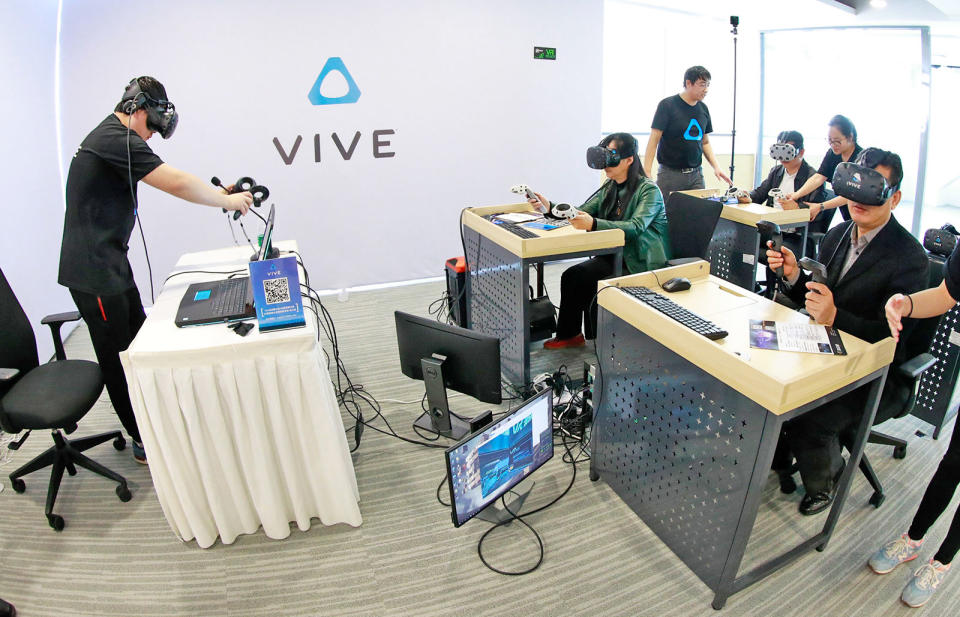HTC targets the classroom with 10-headset Vive bundle
Cinemas and arcades can also take advantage of this, but it's China-only for now.

The folks over at HTC Vive have been talking up the potential of VR in education since day one, and this year, they're hoping to make a bigger push into this space by focusing on multi-user scenarios. At this week's Vive Ecosystem Conference in Shenzhen, the company announced the Vive Group Edition bundle for China, which includes ten Business Edition headsets plus two Business Edition base stations for 49,999 yuan or about $7,260, and it's due to ship in May. This offers a much lower entry barrier for commercial users, as it's almost a 40-percent saving when compared to buying ten full Business Edition kits, meaning schools and small businesses are more likely to afford the system.
For those who are wondering, yes, the Group Edition package is missing the controllers plus extra base stations, and for a good reason. According to the company, the idea here stemmed from a growing number of customer requests for high-end multi-user VR solutions, but that quickly becomes costly as each headset needs to be hooked up to a relatively powerful PC. As such, the only way to lower the cost without too much compromise is by sticking to the bare necessities on the VR side: a number of headsets and just two base stations per room.
While the lack of controllers here may sound worrying, HTC Vive's China President Alvin Wang Graylin assured me that the lean kit is perfectly suitable for light interaction use cases. These can be as simple as watching a video together (so cinemas can also take advantage of this package) to something more fun like going on virtual tours -- be it a seated experience or a room-scale experience. I can imagine students enjoying geography, biology and history lessons more by being virtually transported to different places, and they'll also get a better sense of scale by walking around an animated solar system; these can all get by without controllers, and Graylin added that there are plenty more of such education VR apps in the works.

But of course, customers can always add controllers to their Group Edition orders should their budget allow. This then opens up more opportunities in the classroom. During the conference, HTC showed off a chemistry lesson app which let teachers and students do virtual experiments together using controllers. It may take the fun out of seeing real chemicals fizzing or burning away, but this way the class gets to simulate the more dangerous experiments with no actual risks.
Another somewhat educational app that caught my attention during the conference -- and I know I'm late to this one -- was Night Cafe: A VR Tribute to Vincent Van Gogh (available on Steam), which lets you explore a tranquil world rendered in the style of Van Gogh's painting, and you even get to meet the man himself. Had this technology been available earlier, I might have paid more attention in my art lessons back then.

Graylin also addressed some concerns regarding whether VR is bad for children's eyes. Earlier this year, his company partnered with the Beijing Institute of Technology to study a group of young subjects aged 9 to 12. First, the children each wore a VR headset (presumably a Vive) for 20 minutes, and the result was that 8 percent of them reportedly had worse vision afterwards. But in a second test involving the use of tablets instead of VR headsets, the percentage of subjects with worsened vision went up to 11.5 percent.
What's more interesting is that in the VR test, 20 percent of the subjects actually had improved vision, which was notably higher than the mere 7.7 percent in the tablet test. So in short, VR usage appears to be more beneficial -- or at least less harmful -- to children's eyes than using tablets, but we should take this claim with a grain of salt until more studies come to the same conclusion. Having said that, there are already existing apps that use VR to help restore vision, namely Vivid Vision (formerly Diplopia), Visionize and IrisVision.
It's obviously a bit early to tell whether the Vive Group Edition bundle has the right formula, but Graylin has already set an aggressive target for the education sector in China. Currently, there are "dozens" of local schools that have partnered with HTC Vive, and the exec hopes to turn this figure "into hundreds or even thousands" by the end of this year. If all goes well, here's hoping other markets will also be offered a similar package to increase VR adoption.

